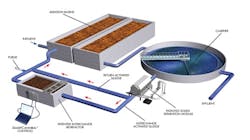Sludge Reduction Solution
In upgrading the municipal wastewater treatment plant (WWTP) in Zeewolde, the Netherlands, Evoqua Water Technologies needed to reduce operational costs for waste-activated sludge (WAS) disposal but keep the excellent effluent quality and not impact the plant’s design capacity.
Built on reclaimed land, the Zeewolde WWTP is one of five run by the local government-controlled water board Zuiderzeeland. Current performance is such that the facility achieves low phosphate and nitrogen limits, without the need for chemical addition.
Still, the operational costs of removing excess sludge are high in the Netherlands, and due to present legislation, all municipal WAS must be incinerated. This leads to high costs for all of the Dutch water boards. The Zuiderzeeland water board, however, was concerned that any sludge reduction would release phosphate, which was otherwise removed through sludge disposal and could impact the plant’s effluent quality. In addition, chemical dosing also would increase the operational costs of the facility.
The Solution
Evoqua proposed the Cannibal Solids Reduction System, a biological batch process aimed at reducing the amount of biological WAS. Based on pilot plant results, it was expected the total yield of the WWTP would be dropped below 0.3 kg/kg BOD, effectively reducing the WAS production by 70%.
In the Cannibal system, a sidestream of activated sludge is stressed in the Interchange BioReactors under oxygen deficient conditions. The interchange activated sludge (IAS) is returned to the main process, where byproducts created in the interchange bioreactors can be further oxidized, reducing generated WAS. To deal with phosphates, Evoqua added another step to the process for separate chemical phosphate removal and possible reuse.
In Zeewolde, two 1,200-cu-meter decommissioned tanks next to the WWTP were converted to Interchange BioReactors. The installation also consists of three small blowers, two mixers, chemical dosing installation and the Smart Cannibal Control System. With the assistance of Dutch research partner TNO, the project won a €500,000 grant for combined biosolids reduction and phosphate recovery.
The Results
